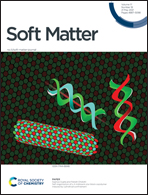A sulfamethoxazole molecularly imprinted two-dimensional photonic crystal hydrogel sensor
Abstract
In this paper, a molecularly imprinted two-dimensional photonic crystal hydrogel sensor (SMZ–MIPCH) for the sensitive and label-free recognition of sulfamethoxazole (SMZ) was prepared. The SMZ–MIPCH sensor response performance was investigated via measuring the diameter of the Debye ring (D). When the SMZ–MIPCH sensor recognized SMZ, the diameter of the Debye ring gradually decreased and the particle spacing (d) of the photonic crystals gradually increased. As the SMZ concentration increased from 0 to 10−4 mol L−1, the diameter decreased by 15.2 mm and the corresponding particle spacing increased by 131 nm. As the diffraction peak wavelength of the sensor gradually red-shifted, the color changed from blue to green and finally to orange-red. A good linear relationship was found between the variation of the particle spacing (Δd) and the value of the logarithm of the SMZ concentration (lg c) in the range from 10−16 mol L−1 to 10−10 mol L−1. The limit of detection of the SMZ–MIPCH sensor is 10−16 mol L−1. In the presence of analogues of SMZ, such as sulfisoxazole, sulfadiazine, and sulfamethazine, the diameter changed only slightly, indicating that the SMZ–MIPCH sensor had specific recognition abilities for SMZ. The SMZ–MIPCH sensor has the advantages of high sensitivity, specific recognition, and naked eye detection, and it can be used for the detection of SMZ in water samples.



 Please wait while we load your content...
Please wait while we load your content...